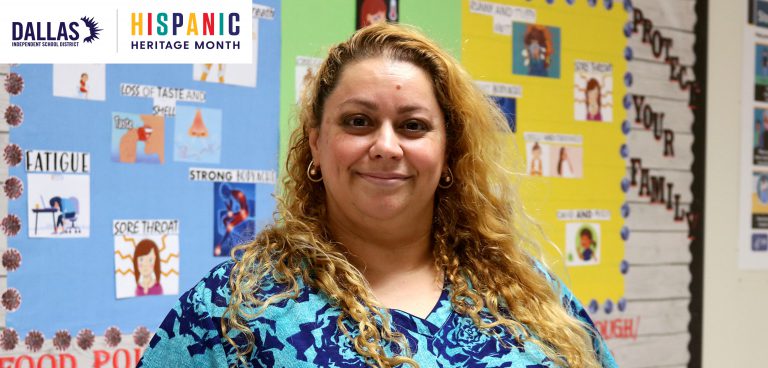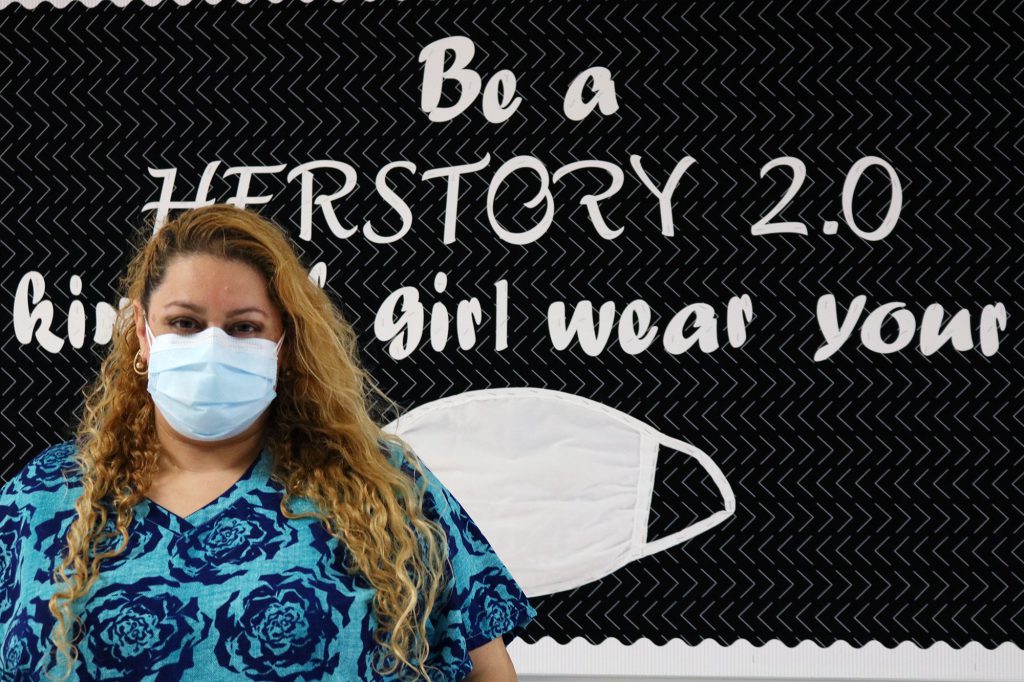While Veronica De La Torres is no longer assisting physicians with open-heart surgeries, she potentially helped save the lives of Dallas residents and Dallas ISD families this summer.
The registered nurse worked tirelessly–inside and outside her clinic at Young Women’s STEAM Academy (YWSA)–to make sure that her students, their families, and the patients at a local hospital survive Covid-19.
YWSA is an all-girls middle school with a number of Special Education units, including an Activities of Daily Living (ADL) classroom. ADL units serve students who exhibit severe to profound cognitive delays and who may also exhibit varying degrees of physical disabilities. As part of her daily duties, Nurse De La Torres checks in with the students in ADL classrooms every day, assisting the students who may require the administration of some medical procedures.
When schools unexpectedly closed in March due to the Covid-19 threat, De La Torres took it upon herself to check-in over the phone with her students and their families. At a local hospital, she was tasked with assisting physicians and helping patients facing Covid-19.
“Nurse De La Torres is known by everyone around here for her no-nonsense health facts!” Principal Gabrelle Dickson said. “In these times, her expertise has been a tremendous asset and source of comfort, especially for our staff embracing the new normal to keep safety and health a priority.”
De La Torres worked as a full-time nurse in Parkland Hospital’s cardiac catheterization laboratory before joining Dallas ISD in 2016. She had just finished a surgery when a district recruiter called her and asked her to meet for a possible job opening. De La Torres was interviewed and hired on-the-spot and has been working as head-nurse in the school ever since.
On weekends and on some weeknights, De La Torres works at a local hospital’s ortho/neuro trauma unit. For the last 10 years, she’s treated victims of gunshot and stab wounds and motor-vehicle accidents.
Nurse De La Torres talked to the Hub about her work inside and outside the school during the height of the coronavirus pandemic.
You volunteered to call your students during the summer months. How did your routine check-ins turn into live-saving phone calls?
I called five students every day, and these are kids who have medical issues listed. The entire point of the conversation was to see what they needed and what I could do to try to help them.
Many conversations were to make sure that my kids who need medications were able to get a hold of a doctor. A lot of physicians’ offices were not accepting visits and a lot of the medications that my students need require an office visit. So, I’d talk to their parents and teach them how to schedule an online visit or I’d help them find another doctor.
Very soon, I started realizing that we had a lot of kids whose parents were ill.
A lot of the phone calls were long. I sometimes spent 45 minutes to an hour on a single call, talking to each family member about their concerns. In many cases, the parents would go to a hospital and test positive for Covid-19 and, unfortunately, they’d just be sent back home and receive no treatment. Maybe when they were given the test, their symptoms were not that bad, but all of a sudden they’re having trouble breathing. Then fathers started getting sicker, and sicker and sicker; mothers were getting sicker, and sicker, and sicker. And the kids were really concerned.
By making these calls, I helped move parents and children into the hospitals.
What was important to me was making sure that our kids and their families were protected, and helping them get that protection. If the child is worried about their family, they’re not going to be doing well in school, they’re going to be distracted, or not getting enough sleep. We want to protect everyone that we can.
What was it like to treat people with COVID-19 during the height of the pandemic?
I was there before and when COVID-19 hit. (At the local hospital), we created a separate Covid unit and I helped open that unit.
It was a really difficult time for people. Everyone was really scared about the virus. Nobody really knew how it was being transmitted at the beginning, there was no definite way to treat it and people were dying left-and-right. The testing was not as accurate at the beginning as it is now. Families were torn apart because there were no visitors allowed. Nobody could talk to the patients and they were rapidly moving from the Covid unit to ICU.
My priority there was to be with those families and to try and help them make the best decisions for themselves and their families. I had people who would come in unable to breathe, but they would want to go home and be with their families. I had people saying: ‘I want you to write this down, nurse. This is my will at the end of life.’ And I’m like: ‘I’m not giving up. You better not give up.’
I helped facilitate the iPads in the Covid-19 units so that they could at least do online chats with their families and see their faces back and forth. Translators were not allowed in the room and nobody could translate vital information to them in person. It had to be done through a phone. A lot of the patients did not fully understand their options.
I really made it a point to go to all the patient’s rooms that spoke Spanish, every day. I would try to gather their family and explain to them ‘This is what’s going on with your mom. We have got to work fast. We don’t have a whole bunch of time. We have to make a decision quickly so that we can save her and keep her well.’ And when you present it to people like that, with a sense of urgency, decisions happen. It was really about saving their lives and making sure they were getting true quality treatment.
What is your message to students who are still confused about this current crisis?
First of all, don’t put your guard down. This virus has made a lot of people sick, and doctors and health experts are working hard to help people stay healthy. Keep washing your hands thoroughly, avoid going to crowded places if possible and keep wearing a face covering in public. Even though everything seems to be reopening, we’re not out of the woods yet and we must remain following safety guidelines.
With that being said, I want to tell students that this too will pass, sooner or later.
I try to tell them to enjoy the moment and really take advantage of the opportunities that they have. If you’re at home most of the day, this is a good time to exercise and ride your bike, or walk your dog.
This is the time to take advantage of going outside to exercise, while maintaining social distancing. Kicking up endorphins produces the feeling of wellbeing.
I also ask my students, ‘What kind of hobbies do you have? What do you like to do?’ And then they tell me little things and I tell them that this is the time to experience it. If you ever thought about learning to cook, this is definitely the time to do it! If there are projects that you’ve always wanted to do, start those projects! And once you become immersed in that, the nonsense of what you used to do goes away because you’re feeling happy and achieved to accomplish a goal.


